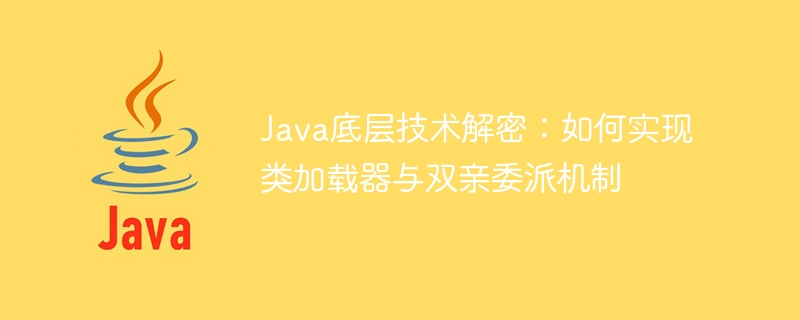

Decryption of Java underlying technology: How to implement class loader and parent delegation mechanism
Introduction:
In the Java world, class loader and parent delegation mechanism is a very important concept. They are the underlying technology of the Java Virtual Machine (JVM) and are used to load class files and ensure the uniqueness and security of classes. This article will introduce the principles of the class loader and parent delegation mechanism in detail, and illustrate it through specific code examples.
1. The concept and classification of class loaders
The class loader is an important part of the Java virtual machine implementation. Its main function is to load class files from the file system, network or other sources to the JVM. , and generate the corresponding Class object. Let’s first understand the classification of class loaders:
In addition, you can also customize the class loader to implement specific loading functions.
2. The working principle of the class loader
The advantage of this mechanism is that it can ensure that duplicate classes will not appear in the JVM. When a class loader receives a loading request, it will first check whether it has already loaded the class. If it has been loaded, it will directly return the loaded Class object; if it has not been loaded, it will hand over the request to the parent for loading. The loading operation is completed by the parent loader. This delegation goes up layer by layer until the top-level startup class loader.
3. Specific implementation and code examples
In order to better understand the class loader and parent delegation mechanism, a simple code example is given below:
public class CustomClassLoader extends ClassLoader { // 自定义加载类的逻辑 @Override public Class loadClass(String name) throws ClassNotFoundException { // 自定义加载类的实现,这里假设加载失败了 throw new ClassNotFoundException(name); } } public class ClassLoaderTest { public static void main(String[] args) throws Exception { // 创建自定义类加载器的实例 CustomClassLoader myClassLoader = new CustomClassLoader(); // 尝试加载java.lang.String类 Class clazz = myClassLoader.loadClass("java.lang.String"); // 输出类加载器 System.out.println(clazz.getClassLoader()); } }
Above In the code, we customized a CustomClassLoader subclass of ClassLoader and overridden the loadClass method. In the loadClass method, we assume that loading the class failed and threw a ClassNotFoundException.
Next, we created an instance of CustomClassLoader in the main function and tried to load the java.lang.String class. Because our custom class loader cannot load the system core class library, a ClassNotFoundException exception will be thrown.
Finally, we print the ClassLoader information that loads the Class object of the java.lang.String class. Because the loading failed, the output result is null.
This example shows the application of class loader and parent delegation mechanism. When loading a class, the custom class loader first delegates the loading request to the parent loader. Only when the parent loader cannot complete the loading task, it will try to load it itself.
Conclusion:
Through the introduction and code examples of this article, we have learned about the principles and implementation of the class loader and parent delegation mechanism. Java's class loading mechanism is an important mechanism to ensure the uniqueness and security of classes, and is also one of the core technologies in the Java virtual machine. An in-depth understanding and mastery of class loaders and parent delegation mechanisms will help us better understand and use Java's underlying technology.
References:
The above is the detailed content of Decryption of Java underlying technology: How to implement class loader and parent delegation mechanism. For more information, please follow other related articles on the PHP Chinese website!
